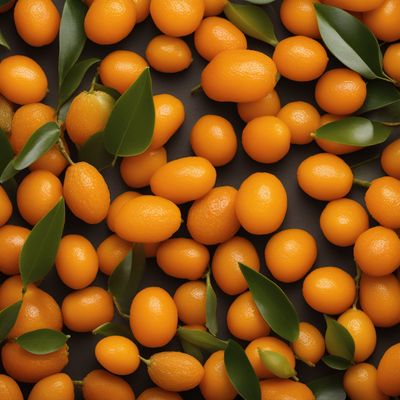
Ingredient
Nagami kumquats
The Tangy Delight of Nagami Kumquats
Nagami kumquats are small, oval-shaped fruits with a thin, edible skin and a juicy flesh. The skin is bright orange and slightly bumpy, while the flesh is tart and acidic. When eaten whole, the sweet peel balances out the sour juice, creating a delightful taste experience. They are often used as a garnish, marmalade, or in salads to add a refreshing citrusy kick.
Origins and history
Nagami kumquats originated in China and have been cultivated for thousands of years. They were introduced to Europe in the 19th century and later made their way to the Americas. In Chinese culture, kumquats symbolize good luck and prosperity, and they are often given as gifts during the Lunar New Year. Today, they are grown in various regions around the world, including the Mediterranean, California, and Florida.
Nutritional information
Nagami kumquats are low in calories and a good source of vitamin C, fiber, and antioxidants. They also contain small amounts of essential minerals like potassium and calcium.
How to select
Choose kumquats that are firm, plump, and have a bright orange color. Avoid fruits that are soft, wrinkled, or have blemishes. The skin should be smooth and shiny. Look for kumquats that feel heavy for their size, as this indicates juiciness. If possible, give them a gentle squeeze to ensure they are not overly ripe.
Storage recommendations
To store Nagami kumquats, keep them in the refrigerator in a perforated plastic bag or airtight container. They can last for up to two weeks when stored properly. Before using, rinse them under cold water and pat dry. If you have an abundance of kumquats, you can also preserve them by making kumquat marmalade or pickling them.
How to produce
Nagami kumquats can be grown in home gardens or containers in regions with a warm climate. They require well-drained soil, regular watering, and full sunlight to thrive.
Preparation tips
Nagami kumquats can be enjoyed in various ways. They can be eaten whole, including the peel, or sliced and added to salads, desserts, or cocktails. They can also be used to make jams, jellies, or infused oils. The tartness of kumquats pairs well with seafood, poultry, or spicy dishes.
Culinary uses
Nagami kumquats are commonly used in Asian cuisines, particularly Chinese and Southeast Asian cuisines. They are often featured in dishes like kumquat chicken, kumquat salad, or kumquat-infused beverages. They are also popular in Mediterranean and Middle Eastern cuisines, where they are used in preserves and desserts.
Availability
Nagami kumquats are commonly available in regions with a warm climate, such as China, Japan, the Mediterranean, and parts of the United States (California and Florida).

